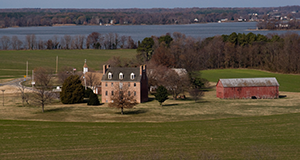
Newtowne Neck was home to the Piscataway people and their ancestors for many centuries before its settlement by English colonists. The property is the site of the second colonial settlement in Southern Maryland. It followed the original 1634 settlement in Saint Mary’s City and the establishment in 1637 of a Jesuit Mission in St. Inigoes, Maryland. Newtown Manor and St. Francis Xavier Church are part of Newtown Neck St. Park in St. Mary’s County.
In 1640, William Bretton was granted 750 acres from Cecelius Calvert for the Newtowne Neck tract. William and his wife Temperance donated one and one-half acres of their property in 1661 to the Society of Jesus to establish a chapel and cemetery. In 1668, the Society of Jesus acquired the remaining acreage of Newtowne Neck from William Bretton in exchange for 40,000 pounds of tobacco. The Jesuits built the current St. Francis Xavier Church in 1731 and New Towne Manor residence in 1789. They operated the plantation with enslaved labor, growing tobacco and corn. At least 56 of those enslaved at Newtowne were sold in the infamous Georgetown 272 sale to benefit the survival and development of Georgetown College (now Georgetown University).
Following the Civil War and emancipation, the farmland at Newtowne Neck was worked by sharecroppers and free labor. The property was maintained by the Society of Jesus until they withdrew from the land in 1967 to work in other areas. The Department of Natural Resources purchased Newtowne Neck in late April of 2009 and established Newtowne Neck State Park.
The Francis Xavier Church is one of three Catholic churches situated on historic Jesuit plantations that continue to serve their parishes. Archaeology at the site is extensive and ongoing.
The 1789 Manor house has undergone recent restoration.
Additional Information
Still, We Speak (stillwespeak.org) website and article
https://apps.mht.maryland.gov/Medusa/PDF/NR_PDFs/NR-110.pdf National Register nomination form
https://cathstan.org/news/local/archaeological-dig-at-st-francis-xavier-parish-in-newtowne-offers-clues-on-life-at-jesuit-plantations-in-southern-maryland article about archaeological investigation of the site and involvement of descendants of people who had been enslaved there.
The 272: The Families Who Were Enslaved and Sold to Build the American Catholic Church, Rachel Swarns (book)
Jesuit Slaveholding in Maryland, 1717-1838, Thomas Murphy, S.J. (book)
